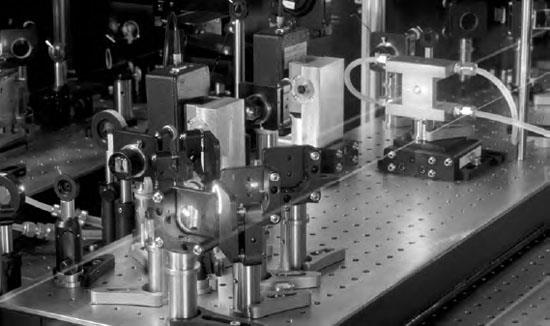What Is the World Made Of?Are Emission and Absorption the Only Ways Light Interacts With an Atom? |
What is quantum mechanics? |
The field of study of atoms by themselves, as well as in molecules, liquids, and solids in which the wave nature is important is called quantum mechanics. The atoms obey the Schroedinger equation, but for any atom more complicated than hydrogen the equation can be solved only by a computer. Using computers to solve equations, run complicated models, and simulate experiments is an important sub-division of the study of physics called computational physics, which now has equal status with theoretical and experimental physics.
Some of the recent accomplishments of quantum mechanics are in the areas of condensed matter physics, or the study of solids, and atomic physics. All of the integrated circuits used in mp3 players, televisions, cameras, and automobiles are designed using quantum mechanics. They are all based on diodes and transistors where quantum mechanics describes and explains their properties and guides materials scientists to select appropriate materials for their construction. One of the most exciting new materials is graphene, a film of carbon where the atoms are in hexagon-shaped arrays, but the film is only one atom thick. Graphene is being investigated as a way of constructing extremely tiny transistors, and thus powerful integrated circuits. It may also be used as a sensor to detect single atoms or molecules of selected materials or as a transparent conductor for touch-screen computer displays. Its discoverers won the 2010 Nobel Prize.
From 1924 to 1925 Einstein and the Indian physicist Satyendra Nath Bose (1894-1974) predicted that if an atomic gas were cooled enough the atoms could form a new state of matter that would exhibit quantum effects on a macroscopic scale. The first experimental confirmation of this prediction occurred in 1995 when Eric Cornell (1962-) and Carl Wieman (1952-) at the University of Colorado cooled a gas of rubidium atoms to about 1/6 of a millionth of a Kelvin. They and Wolfgang Ketterle (1957-) at MIT shared the 2001 Nobel Prize for their work. While this new state of matter, called a Bose-Einstein Condensate, has no existing applications, physicists are using it to improve their knowledge of how atoms interact at very low temperatures and to explore possible future applications to atomic clocks and computers.

